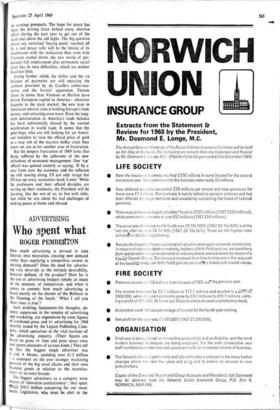Who spent what
ADVERTISING ROGER PEMBERTON
How much advertising is devised to turn . luxuries into necessities, creating new demand rather than supplying a competitive answer to existing demand? Does the need for advertis- ing vary inversely as the intrinsic desirability, however defined, of the product? How far is the size of advertising budgets simply an index of the intensity of competition, and when it comes to Content, how much advertising is based merely on the dictum of the Hellman in the 'Hunting of the Snack,' What I tell you three times is true'?
Such darkling fundamentalist thoughts, de- cently suppressed in the temples of advertising and marketing, are engendered by some figures of combined press and Tv advertising for 1968 recently issued by the Legion Publishing Com- pany, which specialises in the vital statistics of the advertising industry. (Their figures are based on gross Tv time and press space costs and ignore discounts of various kinds.) They tell us that the biggest single advertiser was C and A Modes, spending over £1.3 million —a comment on the ever stronger marketing position of the big retail Chains and their own branded goods in relation to the manufac- turer, of national brands. The biggest advertisers as a category were makers of 'chocolate confectionery': they spent INtly £10.3 million competing for our sweet tooth. Legislators, who must be alert to the often, perverse springs of human behaviour, should note that it was sweet rationing more than anything else which set the British on the road to becoming the world's leading sweet eaters. The second largest advertisers were the cigarette makers, who spent over £9.6 million even though banned from television. A large proportion of cigarette advertising is accounted for by launches of new brands; with smoking habits changing fairly rapidly in response to constantly increasing tobacco duty, there are big rewards for manufacturers who can launch a new brand that catches on, though the failure rate is high. But there seems to be little corre- lation between the market share of established cigarette brands and the advertising expendi- ture on them : which suggests fairly resistant attitudes among smokers to advertising per se.
Sociologists may ponder the fact—the Chan- cellor obviously did too—that, on press and TV at any rate, pet foods at £6.6 million give rise to over a million pounds more advertising than was devoted to beer (£5.4 million), though it is only fair to say that the brewers tradi- tionally spend a great deal on outdoor adver- tising, posters, bus sides etc). Interestingly, too, wine advertising at £4.4 million was creeping up on beer: evidence that the vintners are in- vesting heavily in a buoyant market with enormous growth prospects. More booty here for the Chancellor, too. Finally, lovers (if any) and haters of the little lion may be interested to note that the Egg Marketing Board Spent £920,000 on keeping him alive in the face of grave rejection symptoms.
Whatever may be said about the importance of advertising—to the economy, to the com- petitive principle etc—it has to be, admitted that, like the dropsy, advertising grows by self-indulgence: the more advertising there is, the more it is needed to make a new product heard amid the clamour of voices. By the same token, even the good product has to keep advertising to stay heard. In areas of intense competition, such as detergents, advertising is found to be rather like air cover for military operations—an essential precondition of suc- cessful infighting on the ground by salesmen, merchandising experts and so on. Further than that, the grocer or chemist, with limited space for the lines he stocks, regards advertising as a guarantee that the product will move off his shelves with reasonable speed and can virtually make the advertising support a condition of% • stocking the product.
All the foregoing ;iv- s to the advertising of Particiti- ptolucts and services in cate- .5v!.1 for which there is a known or assumed need. But, of course, a great deal of advertis- ing today is devoted to entirely different propo- sitions, notably advertising by government departments on such topics as recruiting for the services, road safety and that triumph of unwantedness, the fivepenny post. There, for the most part, the 'consumer' simply accepts or rejects the proposition. There is no alterna- tive brand to turn to, no built-in motive to accept it—which is why government accounts, concerned only with what they want you to want, conducted largely on the principles of the Bellman, can be very tough going indeed.











































 Previous page
Previous page